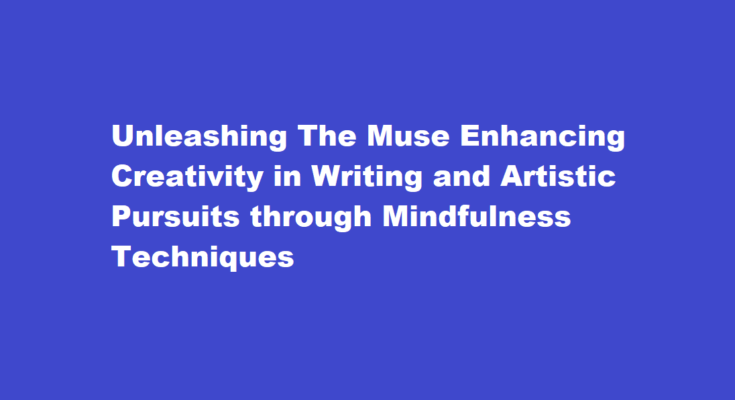Introduction
Creativity is a magical force that drives writers and artists to create masterpieces that touch the hearts and minds of their audience. However, sometimes this spark of creativity can be elusive, leaving creators frustrated and blocked. Mindfulness, a practice rooted in ancient traditions, has gained significant recognition for its ability to enhance focus, reduce stress, and cultivate creativity. In this article, we will explore how mindfulness techniques can be harnessed to improve creativity in writing and other artistic pursuits, providing a fresh perspective to ignite the imagination.
Cultivate Present Moment Awareness
Mindfulness is the art of being present in the moment, fully aware of thoughts, feelings, and sensations without judgment. In the context of creativity, it helps writers and artists focus their attention on the task at hand rather than getting bogged down by past failures or future worries. By grounding themselves in the present, creators can experience a heightened sense of clarity, which facilitates fresh ideas and originality in their work.
Embrace Curiosity and Playfulness
Mindfulness encourages a childlike sense of curiosity and playfulness. Engaging in artistic pursuits with a sense of wonder allows the mind to wander freely and explore uncharted territories. Unleashing creativity often requires breaking free from rigid thought patterns and embracing unconventional ideas. Mindfulness aids in suspending self-doubt and embracing experimentation without fear of judgment.
Overcoming Creative Blocks
Writers and artists often face creative blocks where inspiration seems to have evaporated. Mindfulness teaches acceptance of these blocks instead of resisting them. By accepting the current state without judgment, creators can alleviate the pressure they place on themselves and open up the mental space for new ideas to flow organically.
Mindful Observations
Practicing mindfulness involves observing the world without attachment to preconceived notions. Writers can draw inspiration from simple observations of everyday life, finding beauty and meaning in the mundane. Mindfulness trains the mind to be receptive to details that might otherwise be overlooked, enriching the creative process.
Meditation for Clarity and Focus
Meditation is a core component of mindfulness practice. Regular meditation sessions can help writers and artists sharpen their focus, declutter their minds, and enhance their ability to immerse themselves in their craft. As the mind becomes less distracted, the creative ideas flow more naturally, leading to improved writing and artistic expression.
Mindful Sensory Experience
Engaging the senses mindfully can significantly impact creative endeavors. Writers can heighten their descriptive abilities by paying attention to sensory experiences in their surroundings. By incorporating sensory details into their writing, they can evoke vivid emotions and imagery in their readers. Similarly, artists can use mindfulness to immerse themselves in the process of creating art, focusing on textures, colors, and brushstrokes.
Practicing Non-Attachment
Artists often form strong emotional bonds with their work, leading to self-criticism and resistance to change. Mindfulness encourages non-attachment, allowing creators to view their work objectively. This mindset enables writers and artists to edit their work with an open mind, letting go of what doesn’t serve the final vision and embracing creative evolution.
Mindful Walking and Nature Immersion
Incorporating mindfulness into daily life can also enhance creativity. Mindful walking, where one focuses on each step and breath, can help clear the mind and spark new ideas. Additionally, spending time in nature can serve as a wellspring of inspiration, allowing creators to connect with the beauty and wonder of the world around them.
FREQUENTLY ASKED QUESTIONS
How does mindfulness help writing?
Mindful writing puts just enough distance between you and a “story,” which may help you see it with more clarity. A mindful writing practice can brighten your quality of awareness, helping you to make sense of your thoughts, feelings, and perspectives.
What are 5 benefits of mindfulness?
Mindfulness can: help relieve stress, treat heart disease, lower blood pressure, reduce chronic pain , improve sleep, and alleviate gastrointestinal difficulties.
Conclusion
Mindfulness is a powerful tool that can enhance creativity in writing and other artistic pursuits. By cultivating present moment awareness, embracing curiosity and playfulness, overcoming creative blocks, and practicing mindful observations, writers and artists can tap into their inner wells of inspiration. Meditation and sensory experiences can improve focus and enrich artistic expression, while non-attachment allows creators to refine their work fearlessly. Mindful walking and nature immersion serve as valuable complements to the creative process. Embracing mindfulness as a creative practice can empower writers and artists to unlock their full creative potential, leading to works that resonate deeply with their audience. So, let us embark on this mindful journey and unleash the boundless creativity that lies within us.
Read Also : Unleashing The Thrill Designing and Executing a Large-Scale, City-Wide Treasure Hunt for Charity



